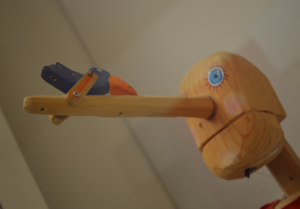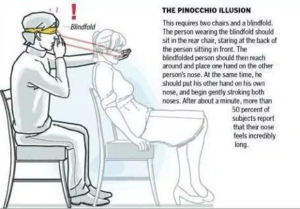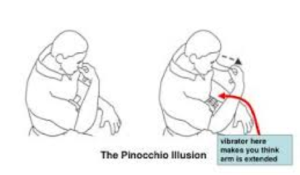Written by Grey Grettum, Taylor Mac, Julie Terrone, and Katie Velek
Pinocchio is a very well known Disney character, and he is cursed with having an enlarged nose every time he tells a lie; however, you may not have heard of the illusion named after his curse! The Pinocchio illusion, also known as the Phantom Nose illusion, was first introduced and reviewed in a famous paper by James Lackner in 1988. This illusion is known to manipulate our sense of proprioception. Proprioception is having knowledge of where your body is in space regarding position, motion, and equilibrium, according to the medical definition of proprioception. The sense of proprioception is crucial to our everyday life in order to sense where we are in relation to the world. By using the Pinocchio illusion, we can distort our proprioceptors’ experience. When this illusion is being performed, you will sense your nose becoming longer, just like our friend, Pinocchio, or that your nose is displaced further away. Unlike Pinocchio, however, this illusion can occur without telling lies.
The Pinocchio Process
There are many different ways to induce this illusion.
The first way requires you to grab a friend that you are comfortable with. Since you will be the one experiencing the illusion, you will sit in a chair behind your friend. You should cover your eyes by either using a blindfold, or simply closing them. Next, you will reach out with whatever hand and simply find the nose of your friend, while using your other hand to touch your nose. At the same time stroke your nose as well as your friends using the same movement. In roughly thirty seconds to one minute, you may get a weird sensation that your nose is displaced from your body, or that your nose has grown super long. It is also possible that you might experience both of these outcomes!
If you do not experience the illusion yet, a third person can be used to help induce the effect. Instead of stroking both noses yourself, the third person (the inducer) will stroke your nose for you. Though you will still stroke your friends nose sitting in front of you, you have eliminated the distraction of stroking your nose, increasing the chances of experiencing the Pinocchio illusion.
If you want to know another way to induce this illusion than go no further because there is a third way of experiencing the Pinocchio effect. This method is more complicated, requiring a physiotherapy vibrator. You attach the vibrator to your arm and then using the same hand on the arm of the vibrator, touch your nose. The vibration sensation tricks your brain to interpret the situation as if your arm was moving so it thinks that your nose is elongated. Whichever way you decide to perform the illusion all of the outcomes should be somewhat similar.
Why does this happen?
The Pinocchio illusion is a complicated process and has several different explanations as to why it happens. First, the brain has a contradiction to resolve dealing with the location of your outstretched hand that is touching what feels like your nose. In essence, your brain is trying to understand how come your hand is out there tapping a nose, but you feel your nose being tapped too without any visual stimuli to tell you differently. Your brain does not like contradictions, it likes solutions. And the solution it comes up with is, that your nose is really that long. In scientific terms, the brain is receiving both sensory and tactile information about the same object (the nose) in two different locations, one close to you and one far away. Though your hand is touching the nose far away your brain thinks that it’s touching your nose and here comes the big lie, a long nose. Due to the different stimuli being evoked at the same time, our brain gets the location and dimensions of our nose confused.
Second, According to Kilteni, Maselli, Kording & Slater (2015), the Pinocchio illusion is a type of Body Ownership Illusion (BOI) where you mistake other objects (i.e. your friend’s nose) as your own. This happens due to our body schemas being “built in real-time, on the basis of the stimuli that are currently available to the brain,” according to Vesia and Crawford (2012). During this process, your proprioceptors get confused, which revise your body schema accordingly, causing your nose to seem to grow in order to fill the gap.
Conclusion
The Pinocchio illusion, also known as the phantom nose illusion, is not one based on lies; however, this illusion does trick your proprioceptors. As a result of the illusion, your brain tells you that your nose is extremely long or far away, but in reality, that feeling is just an illusion. The Pinocchio illusion helps explain that our body schema is not as concrete as we want to believe. As shown by the Pinocchio illusion, our body schema can change within thirty seconds to one minute! As complex and high-functioning as our brains are, they sure are easy to trick!
References
Burrack, A., Brugger, P. (2005). Individual differences in susceptibility to experimentally induced phantom sensations. Body Image,2, 307-313.
Lackner, J.R. (1988). Some proprioceptive influences on the perceptual representation of body shape and orientation. Brain, 111, 281-297.
Lawton, G. (2007). Mind tricks: ways to explore your brain. New Scientist, 195(2622), 34–41. https://doi-org.ezproxy.gac.edu/10.1016/S0262-4079(07)62411-7
Medical Definition of Proprioception. (n.d.). Retrieved from https://www.medicinenet.com/script/main/art.asp?articlekey=6393
Vesia, M., & Crawford, J. (2012). Specialization of reach function in human posterior parietal cortex. Experimental Brain Research, 220(3/4), 1–18. https://doi-org.ezproxy.gac.edu/10.1007/s00221-012-3158-9


